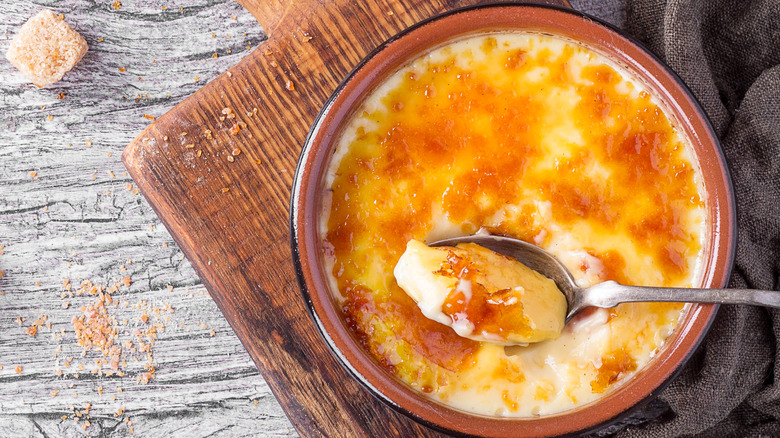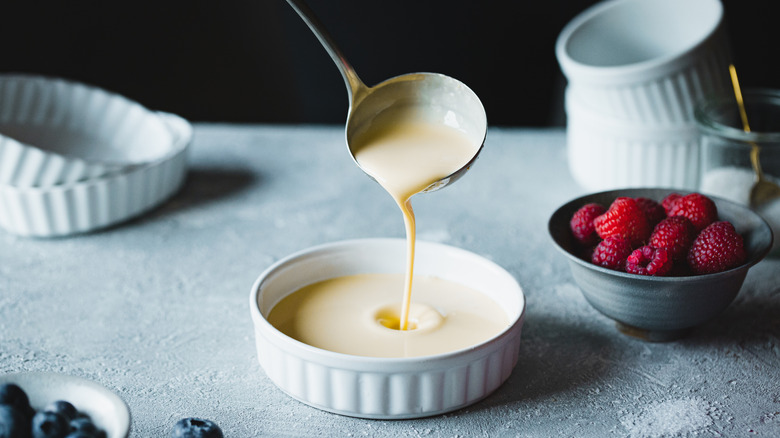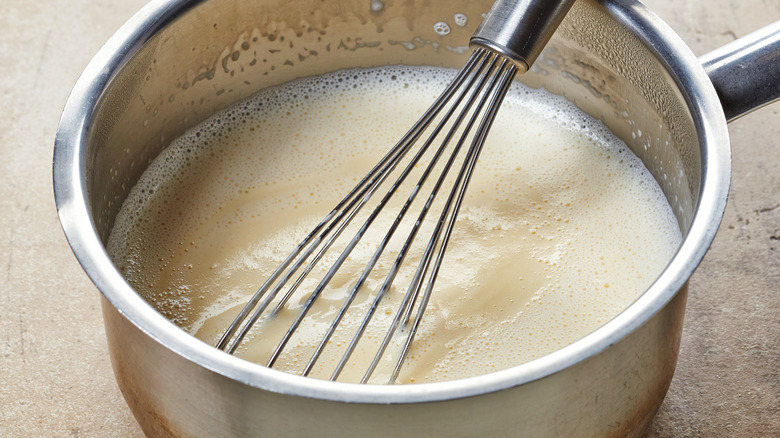For Perfect Crème Brûlée, The Dairy Ratio Matters
Crème brûlée is not just a dessert; it's an experience: a slightly chilled white ramekin is brought to the table, the crisp golden crust is cracked, giving way to a rich, eggy-yellow custard, redolent with vanilla. Each bite has that satisfying slight custardy yield, along with a sweet, delicate crunch of caramel. While this type of dish might seem like the province of a reputable French restaurant (and despite the fact that you'll need a kitchen torch), the last thing you need to worry about when making crème brûlée at home is the custard — as long as you get the dairy ratio right: To achieve the right balance between velvety and rich, use equal parts heavy cream and whole milk.
It turns out that crème brûlée recipes are like opinions and, well, other things: Everybody has one. There are those who swear by using heavy cream exclusively, and those who prefer none at all. Some people split the difference with half-and-half (and what exactly is half-and-half, anyway?). While experimentation in all things cooking is strongly encouraged, it's important (especially with something as fussy as a custard) to learn the most reliable master recipe before adjusting to individual tastes.
Custard contains worlds
There are many types of custard, even though in general terms it's a simple mixture of eggs (usually just their yolks), milk (and/or cream), and sugar thickened over heat. A crème anglaise can be poured like cream, while crème brûlée should be quite dense. Custards can be baked in a bain-marie, cooked on the stovetop, steamed, or thickened with gelatin. What differentiates them is texture (and the quality of ingredients, of course: Buy only the best whole milk).
For a perfect crème brûlée, you want whipping cream richness — but not too much, or you won't be able to finish a serving. You also want the kind of firm set that whole milk provides — but not if it's rubbery. Using the two dairy options in equal measure will yield the best of both worlds, and the most balanced, satisfying results. To prove this particular rule, let's look at its opposites.
The Goldilocks rule of crème brûlée dairy ingredients
Let's say — like many people — you rely exclusively on heavy cream when assembling your crème brûlée. Will it be luxuriously thick and rich? Without a doubt: This stuff is at least 36% milkfat. But unless you're also into itty-bitty portion control, it's going to be a difficult dessert to finish (remember, there will also be about a half-dozen egg yolks in the recipe too!). After the first couple of bites (which will, admittedly, be sumptuous), the mouthfeel is going to get cloying and heavy; a slog that will only intensify with consecutive bites.
Conversely, if you only use whole milk, you're going to get a firmer set on your custard. The reason for this is that it's water, not fat, that helps the egg proteins to form gel-like strands rather than the grainy yolk of even a perfect hard-boiled egg. Milk has significantly less fat than heavy cream, it's mostly water — which guarantees a set custard. However, the sproingy texture of your resulting dessert is far more likely to resemble crème caramel than crème brûlée, lacking the needed density and fullness of flavor that heavy cream provides. So, remember the crème brûlée dairy ratio: one part heavy cream for richness and body; one part whole milk for custardy texture.


